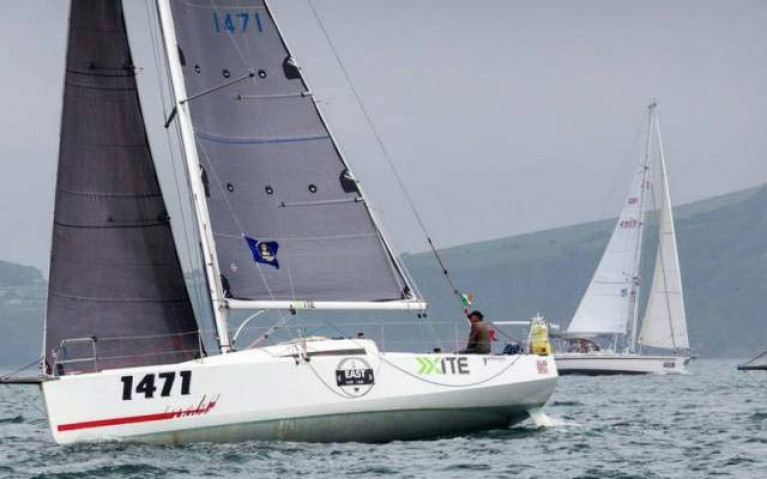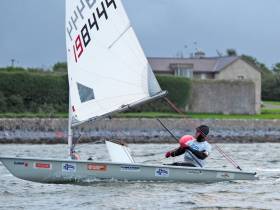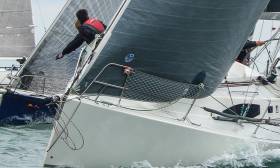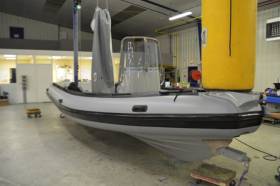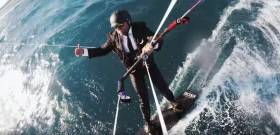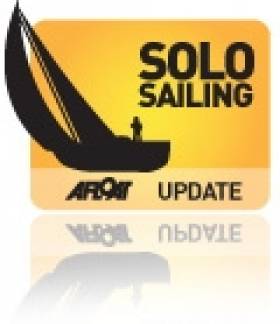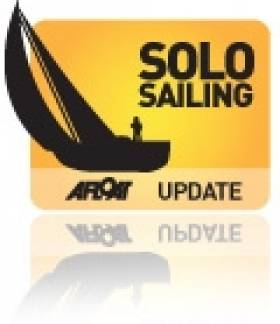Displaying items by tag: solo
OSTAR & TWOSTAR Races Get New Date in May 2021
The Royal Western Yacht Club of England has announced the rescheduling of its OSTAR TWOSTAR that was postponed in 2020 due to the COVID 19 virus, to a new date of May 9th 2021.
The 2021 race will continue to run between Plymouth England and Newport Rhode Island as before.
Ireland has previous success in the OSTAR Race through the pioneering efforts of Cork Harbour solo sailor Barry Hurley who took a class win in 2009 and more recently with Howth Yacht Club's Conor Fogerty who raced to success in 2017.
A new 2021 Notice of Race, Entry form and World Sailing 2020 - 2021 Offshore Safety Regulations for Cat 1 yachts can all be downloaded from the event website.
Galway Bay Sailor Rounds Ireland By Laser
#Laser - The Galway Advertiser is reporting that Galway Bay Sailing Club member Richard Hayes has completed a solo circumnavigation of Ireland by Laser dinghy.
Hayes sailed 54 days over three-and-a-half months since 27 May to complete the near 2,500km challenge last Friday 14 September in aid of heart and stroke charity Croí — and he is still raising funds for the remarkable effort online.
“This is one of the smallest boats ever to have circumnavigated Ireland and to have successfully done so without a support team on the water,” Hayes shared on Facebook of the achievement.
W M Nixon's Sailing On Saturday this weekend (22nd September) takes a detailed look at Richard Hayes’ great achievement, and other notable small boat voyages round Ireland
Round-Ireland Kayaker Has Sights Set On Biggest Goal Yet
#Kayaking - A German woman who circumnavigated Ireland by kayak in 2016 is taking the story of her remarkable global padding adventures on tour across Europe, as the Irish Examiner reports.
Freya Hoffmeister recently returned to Ireland to give talks in Dublin and Cork on her epic solo kayaking voyage around South America, which she undertook in sections over more than 30 months between 2011 and 2015.
Before that, she paddled around Iceland in what’s regarded as the ‘K2 of sea kayaking’, and took on New Zealand’s South Island that same year.
The speaker and endurance athlete also holds a circumnavigation of Australia among her host of achievements — with her next being the mammoth undertaking of North America, which will require kayaking through the treacherous Northwest Passage.
But as lofty as these goals might seem to the average human, Freya brings things down to earth in her motivational talks, on which the Irish Examiner has more HERE.
Search For Missing Chinese Sailor Guo Chuan Called Off
#GuoChuan - Record-setting Chinese offshore skipper Guo Chuan has gone missing on a solo crossing of the Pacific, according to BBC News.
Guo Chuan had connections with Ireland as a crew-member on Irish-Chinese backed Green Dragon and became the first-ever Asian participant, with skipper Ian Walker in the 2008/09 Volvo Ocean Race
US Coast Guard teams now suspended their search in the waters off Hawaii where Guo’s boat was spotted abandoned shortly after his support team lost contact on Tuesday morning Irish time.
Guo’s yacht, the Qingdao China, was reportedly seen from a search plane with its main sail snapped off some 1,000km off Oahu.
Rescuers boarding the boat later found his lifejacket among his belongings.
The experienced sailor had been attempting to break the speed record for a solo Pacific crossing, which currently stands at 21 days.
A year ago, Irish offshore sailor Jarlath Cunnane was among the first to congratulate Guo on a record transit of the North East Passage with a team on board his 26.5m trimaran.
China’s best-known sailor previously sailed around the world in a 12m yacht in 2013.
* The USCG has suspended the search:
UPDATE: COAST GUARD SUSPENDS SEARCH FOR MISSING CHINESE TRANS-PACIFIC MARINER
HONOLULU — The Coast Guard suspended the active search Wednesday evening for a Chinese mariner who was unreported while sailing his 97-foot super trimaran across the Pacific.
Guo Chuan, 50, remains missing.
"Mr. Chuan was a professional mariner with a deep passion for sailing," said Capt. Robert Hendrickson, chief of response, Coast Guard 14th District. "Our thanks to our Navy partners who helped us search for this vessel in a timely manner so far from shore in an attempt to locate Mr. Chuan. Our deepest condolences go out not only to his family and friends but also to his racing team and the sailing community."
Coast Guard HC-130 Hercules crews conducted six search patterns in the vicinity of the Quindao China and its charted course following notification of the situation Tuesday and into Wednesday. The USS Makin Island deployed an MH-60 Seahawk helicopter Wednesday once they were in range to attempt contact with Chuan. Their hails over the radio went unanswered and weather conditions prevented safe deployment of a rescue swimmer to the vessel. They followed up by deploying a rigid-hulled inflatable boat and crew to conduct a boarding of the trimaran Wednesday afternoon. The boatcrew confirmed Chuan was not on the vessel although his life jacket remains aboard.
Weather on scene was reportedly 23 mph winds, seas to 5-feet with good visibility and scattered clouds.
On-scene assets searched a total area of more than 4,600 square miles over the two-day period.
Involved in the search were:
- HC-130 Hercules airplane crews from Coast Guard Air Station Barbers Point
- USS Makin Island (LHD 8) homeported out of San Diego
- Navy MH-60 Seahawk helicopter crew attached to the USS Makin Island
The Quindao China remains adrift, the mainsail has been doused and the vessel has been marked. A broadcast notice to mariners alerting vessel crews in the area to the potential hazard to navigation has been issued. Chuan’s racing team is making arrangements to recover the vessel.
Tuesday morning, watchstanders at the Coast Guard Joint Rescue Coordination Center Honolulu received notification from Maritime Rescue Coordination Center China personnel that the vessel Qingdao China, with one person aboard, had not been heard from for 24 hours prompting the response.
The Makin Island is an amphibious assault ship attached to the Makin Island Amphibious Ready Group and 11th Marine Expeditionary Unit that departed Naval Station San Diego for a scheduled deployment, Oct. 14, to provide maritime security operations, crisis response capability, theater security cooperation and forward naval presence in the Pacific.
Final Call For DMYC Kish Race, 26 Boats Entered So Far
The DMYC in Dun Laoghaire are reminding sailors that online entry for its Kish race on Dublin Bay closes tomorrow at 19.00 on 24th September.
Looking at the weekend forecast – sailing tomorrow may will be for the heavy weather brigade, but Sunday shows some easing even though the WindGuru is predicting gusts in the low 20’s. Does it suggest a spin around the Kish on Sunday would be an ideal way to close out the season?
'The Kish might not be the Vendee Globe, but it still presents a challenge all sailors like', says DMYC's Neil Colin.
#Solo - Pictured above is the RIB that French sailor Christophe Maupaté will pilot solo in his quest to set a new Atlantic record from Bordeaux to New York.
Previously attempted by Ireland's own Enda O'Coineen, no one has yet completed a solo transatlantic voyage by RIB.
But as reported on Afloat.ie last December, Figaro veteran Maupaté has been planning his own crossing for some time, having plotted a 4,460-nautical-mile course that will take him from France via Ireland's East Coast, western Scotland, the Faroe Islands and Iceland to the southern tip of Greenland and Canada's Maritimes towards the US – tracing the route of Lafayette's Hermione.
Now Maupaté's record attempt is just weeks away, launching from Bordeaux on Saturday 16 July with a stopover in Dun Laoghaire expected in the first few days.
Having established himself as a daredevil of the sport of sailing, this latest stunt involves frequent Cork Harbour visitor Alex Thomson, on a kiteboard, chasing his IMOCA open 60 HUGO BOSS boat upwind and attaching himself via a rope to the top of the boat’s mast. The solo skipper then utilises the speed of the race boat to propel himself 280ft into the air, sending him surfing above the vast yacht. When Thomson reaches the peak of his flight, he detaches himself from the boat and expertly controls his descent back down, landing the kiteboard on the water in true Alex Thomson style, all whilst wearing a stylish BOSS suit.
Thomson is captured during the feat in a series of remarkable still images, as he kitesurfs more than twice the height of his HUGO BOSS mast, a height equivalent to a 25–story building.
With a passion for pushing himself to the limit – and having previously executed two other death-defying challenges out on the water - solo skipper Thomson was keen to complete the trilogy of stunts.
The Skywalk was carried out by Alex Thomson Racing, in partnership with sponsors HUGO BOSS and Mercedes-Benz. In total, 35 people were involved in the planning, co-ordination and execution of the stunt, including Alex Thomson Racing Operations Manager Ross Daniel, professional kite-surfer Susie Mai and kite-surfing coach Ray Kasper.
Having safely returned to dry land Thomson commented: “The previous two stunts that we carried out - The Mastwalk and The Keelwalk - were so successful that, as a team, we just knew we couldn’t stop there. We were all in agreement; we wanted to do something even bigger and better.
“I’ve always had a love for all things wind-powered so naturally a stunt which involved kite surfing was the next step. The idea of combining two of my favourite sports and executing something which, to our knowledge, had never been done before was really exciting.
“The team and I have been planning the stunt for a long time. There were lots of things that could have gone wrong. Perhaps most concerning for the team; was the prospect of an uncontrolled descent, causing me to come back down too fast. Water can be as hard as concrete if hit with enough velocity, so this was one of the most dangerous aspects of the stunt. But I had a brilliant team around me and, with their help; we managed to pull it off.”
“What’s next? Who knows?”
This is the third daring stunt to be unveiled by the 41-year-old yachtsman and his team. Videos of The Keelwalk – a challenge which involved Thomson walking along the orange keel of his racing yacht, whilst heeled over and sailing at high speed – and The Mastwalk – which saw the skipper climb the 30 metre mast of HUGO BOSS and dive from the very top into the water – have now been viewed by more than 4.5m people around the world.
Thomson will compete in the pinnacle event of the Ocean Masters race calendar – the Vendée Globe - later this year, a race which begins on November 6th. The non-stop, solo, unassisted, round the world race takes approximately 80 days to complete. In the last edition of the race, back in 2013, Thomson finished in third place. This time around he is determined to be the first Brit to win the prestigious title.
Ireland's Thomas Dolan Lying 19th in Mini Transat îles de Guadeloupe
County Meath's Thomas Dolan lies in the top half of the Mini Transat îles de Guadeloupe fleet after Saturday's start from Douarnenez, France. The sole Irish competitor in the solo race is 19th from 45 and 30 miles behind the overall leader in the 4,000 mile race.
There has been a decided chance of scenery on Mini Transat îles de Guadeloupe. With the arrival of a front, rain and wind have joined the party whilst the boats reach speeds in double digits. Aboard the Minis, they dropped the VHF and naps to concentrate on sailing the boat. The men from the west came back strongly. This will be without Roman Mouchel, forced to return to port after breaking a finger. The sailors out to the West make their comeback. Romain Mouchel forced to return to port after suffering a broken finger.
The sailors who took the southern route could congratulate themselves again this morning on the perfect strategy, now need to look behind them , where the cavalry of the western group is closing in on them. When they are going no faster than an average of 6 knots, Davy Beaudart (Flexirub) who is thirty miles further west skims along at more than 12 knots, and trailing in his wake, the larger group from the circuit. At this rhythm, they should be in the vicinity of the DST cap Finistere by tomorrow morning.
In the west again
On board the Minis, the chatty conversations over the airwaves from the calmer hours have stopped . It ‘s now all about making the boats go more quickly, while knowing that the wind will ease off somewhat after this front has passed over. In this changeable sea, the competitors are mostly sailing under Code 5, the sail for a slightly lighter wind than a spinnaker. That urges on the leading boats , as everyone knows that each mile gained counts twice as much as soon as the wind dies down.
In the prototypes, there are variable fortunes : Alberto Bona (onlinesim.it) sees his throne wobble. Between Vincent Grison (Roll my Chicken) and Frédéric Denis (Nautipark) there is almost 10 knots of speed between them. It’s clear that the cards will be shuffled quickly. There are now about 50 miles’ gap between the leaders and Pilar Pasanau (Peter Punk) who is bringing up the rear in the prototypes .
In the series boats, can the leading trio of Julien Pulvé (Novintiss), Patrick Girod (Nescens), and Charly Fernbach (Le Fauffiffon Hénaff) fend off the acceleration by Yann Claverie (Map Product) who has played an intelligent game in the west ? He should also try to contain the advances of the ambitious Benoît Hantzperg (YCA Dhumeaux Secours Populaire), Ian Lipinski (Entreprise(s) Innovante(s)) et Tanguy Le Turquais (Terréal) who are all bowling along at 10 knots.
Eastern point for Roman Mouchel
The dream of all Mini-ists is to bowl along under a spinnaker. Romain Mouchel is deprived of that at the moment. The diagnosis, relayed by PSP Flamant, seems to confirm that the sailor has broken his finger and can’t therefore continue in his usual form. For now, Roman is heading towards Lorient before taking a final decision. WE’ll ahve to wait to find out if his taste for adventure will overtake his disappointment about not being able to compete for the leading positions. Whatever the decision, it will be his alone to take, He has about 20 hours at sea to mull over his choices that will be very difficult to take. The Mini transat may be fascinating, but it is often also cruel.
Pierre-Marie Bazin (Voiles des anges - 709 - prototype):
“There are around 20 knots of wind. I’m sailing in between 12 and 16 knots, that’s quick . The moments without any wind have been tough, especially because I didn’t make the right choices. It is a pleasure to sail like this. But the sea is choppy, it is a bit strange”.
Olivier Jehl (Zigoneshi-Wichard – 629 – prototype)
“It is great, it’s finally surfing! There are around 16 to 20 knots. I’m sailing in between 12-13 knots with peaks of more than 15 knots. I’m taking the direct route to Cap Finisterre, it looks like we are going to be in for a good sprint”.
Positions on the 20th September at 15 :00 (TU+2)
Prototypes (Eurovia Cegelec class) :
1 Alberto Bona – 756 – Onelinesim à 1059,5 milles de l’arrivée
2 Davy Beaudart – 865 – Flexirub à 0,6 nm
3 Michele Zambelli – 788 – Illumia à 2,1 nm
4 Jean-Baptiste Daramy – 814 – Chocolats Paries – Coriolis Composites à 2,4 nm
5 Fidel Turienzo – 304 – Satanas à 2,4 nm
Series (Ocean Bio-Actif class)
1 Julien Pulvé – 880 – Novintiss à 1064,1 milles de l’arrivée
2 Patrick Girod – 824 – Nescens à 1,2 nm
3 Charly Fernbach – 869 – Le Fauffiffon Hénaff à 2,3 nm
4 Sébastien Pébelier – 660 – www.mademoiselleiodée.frà 3,3 nm
5 Quentin Vlamynck – 728 – Arkema 2 à 4,7 nm
#solosailing – This Sunday, 14 Corinthian sailors will set sail from Plas Heli, Pwllheli for Baltimore, south west Ireland. These single-handed boats of between 20 and 30 feet long are taking part in the Jester Baltimore Challenge; the course will take them around the notorious Fastnet Rock.
The Challenge is all about personal endeavor and self-reliance. It is a challenge for Corinthian sailors that involves the highest standards of amateur sportsmanship. To compete participants must be over 18, the length of the boat is less than 30 feet and each sailor signs a pledge accepting full responsibility for all their choices!
The longest Jester Challenge takes place every four years when sailors sail across the Atlantic from Plymouth to Newport, Rhode Island, about 3,500 miles. The Jester Baltimore Challenge is a shorter preparation event, covering 250 miles where the Jesters will join the Baltimore Pirate Festival before sailing another 250 miles, or more, returning to their home ports. In around a fortnight they can complete the course, enjoy the Festival and be back in time for work.
Since its inception the Jester Baltimore Challenge has launched from Plymouth, but Pwllheli sailor, Roger Fitzgerald, who has sailed every Jester Challenge since 2006 covering over 22,000 miles at sea, saw an opportunity to launch some boats at Pwllheli. The distance between Pwllheli and Baltimore is the same as from Plymouth to Baltimore but Welsh, Scottish and Irish sailors had the added challenge of sailing to Plymouth for the start. 3 local boats started from Pwllheli in the 2013 Challenge. This year a positive flotilla of 14 boats will be single-handedly sailed from Pwllheli to join the Plymouth fleet on route to Baltimore.
Roger Fitzgerald said: "As we've seen the growth in the numbers of boats starting at Pwllheli in the past two years we're hoping that more northern sailors will be attracted to this unique challenge. Pwllheli has such a great backdrop to start our journey. When you've been at sea for many days, or in my case many months, the beauty of returning to Cardigan Bay is something for all sailors to treasure!"
Stephen Tudor, chairman of Plas Heli Cyf, the new Welsh National Sailing Academy in Pwllheli, said: "It's great to see these little boats using our new visitor pontoons and using the Academy as a base for their sail to Ireland. The courageous sailors are starting their own adventure where it will be just them and their small boats battling against the elements. We hope that we can give them a sendoff to remember!"
2018 Golden Globe Solo Non–Stop Round–the–World Yacht Race
#goldengloberace – To mark the 50th anniversary of the first solo non-stop circumnavigation under sail achieved by Sir Robin Knox-Johnston during the 1968/9 Sunday Times Golden Globe Yacht Race, a new Golden Globe Race is set to start from Falmouth UK on June 14, 2018 – the same day that Knox-Johnston set out on his epic voyage 50 years before.
The announcement today is significant, marking the 46th anniversary of Robin's victorious return to Falmouth in 1969, as the sole finisher in the original Sunday Times event.
The 2018 Golden Globe Race is very simple. Depart Falmouth, England, sail solo, non-stop around the world via the five Great Capes and return to Falmouth. Entrants are restricted to using the same type of yachts and equipment that were available to Sir Robin in that first race. That means sailing without modern technology or benefit of satellite based navigation aids. Competitors must sail in production boats between 32ft and 36ft overall (9.75 – 10.97m) designed prior to 1988 with a full-length keel with rudder attached to their trailing edge, similar in concept to Knox-Johnston's Suhaili.
Australian adventurer Don McIntyre, founder of this 2018 Race says: "The overriding aim is for a race where adventure takes precedence over winning at all costs; one where sailing skill and traditional seamanship, rather than modern technology and outside support, gets you round, and where the achievement truly belongs to the skipper."
McIntyre who completed his first solo circumnavigation in 1991 and more recently retraced Capt. Bligh's Bounty Boat voyage from Tonga to Kupang, West Timor in a similar open boat with minimal rations. He intends to compete in the Race with his Tradewind 35 Betty, one of 13 traditional production yacht types approved for this race.
Another entrant is British yachtsman and adventurer Chris Jacks from Liverpool. Last Autumn, he climbed the summits of 92 Wainwright mountains within 40 days – equivalent to climbing Mount Everest twice.
Two more sailors, one from Australia, the other from Germany, have so far expressed keen interest to compete and are currently finalising their plans. The 2018 Race is limited to a maximum of 20 entrants.
The challenge is pure and very raw for those who 'dare', just as it was for Sir Robin, navigating with sextant on paper charts, without electronic instruments or autopilots.
Sir Robin Knox-Johnston says: "I'm a great believer in the freedom of the individual. I think this race is a great idea, giving an opportunity for those who want to do something special with their lives. You can enter this race in an ordinary seaworthy boat and know that success will be down to personal drive and determination, and not to the biggest budget. I intend to be at the start with Suhaili to celebrate this anniversary and expect to be joined by two other yachts that competed in the original Sunday Times Race."
A prize purse of £75,000 has been budgeted for the 2018 Golden Globe Race, and all who finish before 15:25hrs on 22nd April 2019 (the anniversary of Sir Robin Knox-Johnston's finish) will receive a Suhaili trophy and a refund of their entry fee.




























